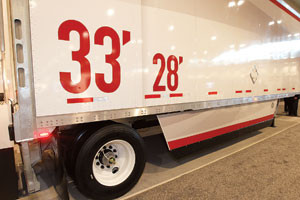Twin 33s Can Offer Benefits

This story appears in the July 6 print edition of Transport Topics.
The twin 33-foot trailer, the first potential nationwide truck-size change in nearly three decades, could generate attractive cost reductions for fleets and broad public benefits in reduced truck traffic, industry experts said.
Legislation that would increase maximum lengths for pup trailers to 33 feet from 28 feet has passed the U.S. House and a key Senate panel. The proposal is expected to be addressed by the full Senate this year.
So far, there is no change to the 80,000-pound weight limit.
If the change becomes law, 33-foot trailers would create an 18% productivity gain for less-than-truckload and parcel carriers. The advent of 53-foot trailers in the 1980s was the last national truck size increase.
“For the [LTL] carriers, the big thing is cost reductions, with fewer drivers, lower fuel expense and fewer miles driven,” Michael Scheid, a senior analyst at SJ Consulting in Sewickley, Pennsylvania, told Transport Topics last week.
Full adoption of 33-footers would require about 25,000 fewer trailers to move the same amount of freight and cut miles driven by 1.3 billion annually, Scheid said.
He gauged $1.7 billion in annual cost savings for LTL carriers at full implementation, excluding the cost of new equipment. Package carriers could save more than $1 billion, he added. LTL carriers now run about 140,000 28-foot pups, with about 80,000 used to carry packages at UPS Inc. and FedEx Corp., he said.
FedEx and Estes Express Lines executives said they strongly support the move.
“Now is the time to introduce a new era of efficiency and safety to the market through use of extended twin trailers,” said Michael Ducker, president of FedEx Freight, the nation’s largest LTL carrier. “More capacity means fewer trips, fewer trucks and less congestion, resulting in better environmental stewardship.”
“We support the current legislation in Congress and feel the added cube of five extra feet per trailer with no weight-limit increase will significantly reduce truck traffic,” said Rob Estes, CEO of Estes Express.
The Association of American Railroads, a staunch opponent of any truck size and weight changes for decades, is not taking a position on twin 33s, spokesman Ed Greenberg told TT.
“[Size and weight] limits were imposed largely because of concerns about the safety of longer and heavier trucks and the uncompensated highway damage they cause,” according to AAR’s current policy.
After a Senate committee adopted the 33-foot trailer provision June 25, the Coalition for Efficient and Responsible Trucking urged the Senate to pass the bill.
“For the first time in more than three decades, national highways are posed to see a meaningful reduction in truck traffic along with safety provisions that, taken together, will prevent more than 900 highway crashes per year,” the group said. Its members include UPS and Con-way Freight.
Some obstacles remain, including a potential veto of the funding measure by President Obama, as well as opposition from several Democratic senators and interest groups.
For example, Public Citizen late last month said truckers are “using backdoor tactics to weaken truck safety rules.”
Its president emeritus, Joan Claybrook, in a statement envisioned “a grotesque increase in the size of trucks.”
Elsewhere, some trucking executives said they see limited applications.
“We are not really excited about [33s],” said Ed Vander Pol, co-president of Oak Harbor Freight Lines Inc.
“We would prefer triple trailers with 28-foot pups,” Vander Pol said, because it would better fit the LTL fleet’s operating plan on key routes.
“Triples have been proven to be very safe,” he added, though he noted that state regulatory hurdles and opposition from railroads to using them would have to be overcome.
Joe Finney, chief operating officer at Dependable Highway Express, said, “We would use very specific routes to run the equipment to get maximum utilization.”
Longer trailers might help to attract backhauls from truckload fleets, he said.
Finney also noted equipment-related factors, saying the company already has trailer orders stretching into next year. If the longer trailers are allowed, he said, Dependable will switch orders to 33-footers within the capabilities of the trailer makers.
Tom Connery, president of New England Motor Freight, said, “33-foot trailers are not as critical to us because we don’t really run pups.”
His company primarily uses 48- and 53-foot trailers for linehauls. Connery also said, “We’re certainly in favor of any way to increase productivity.”
SJ’s Scheid projected a 6-point operating ratio improvement through reduced linehaul wages, fuel and maintenance costs.
He added that 33-foot trailers could become a competitive advantage for some, though “it is a big expense to replace those trailers. A lot of companies won’t be able to afford to replace them.”
“If it happens, we would anticipate a quick conversion by most LTL fleets,” Stifel Nicolaus analyst David Ross said in a report to investors.

